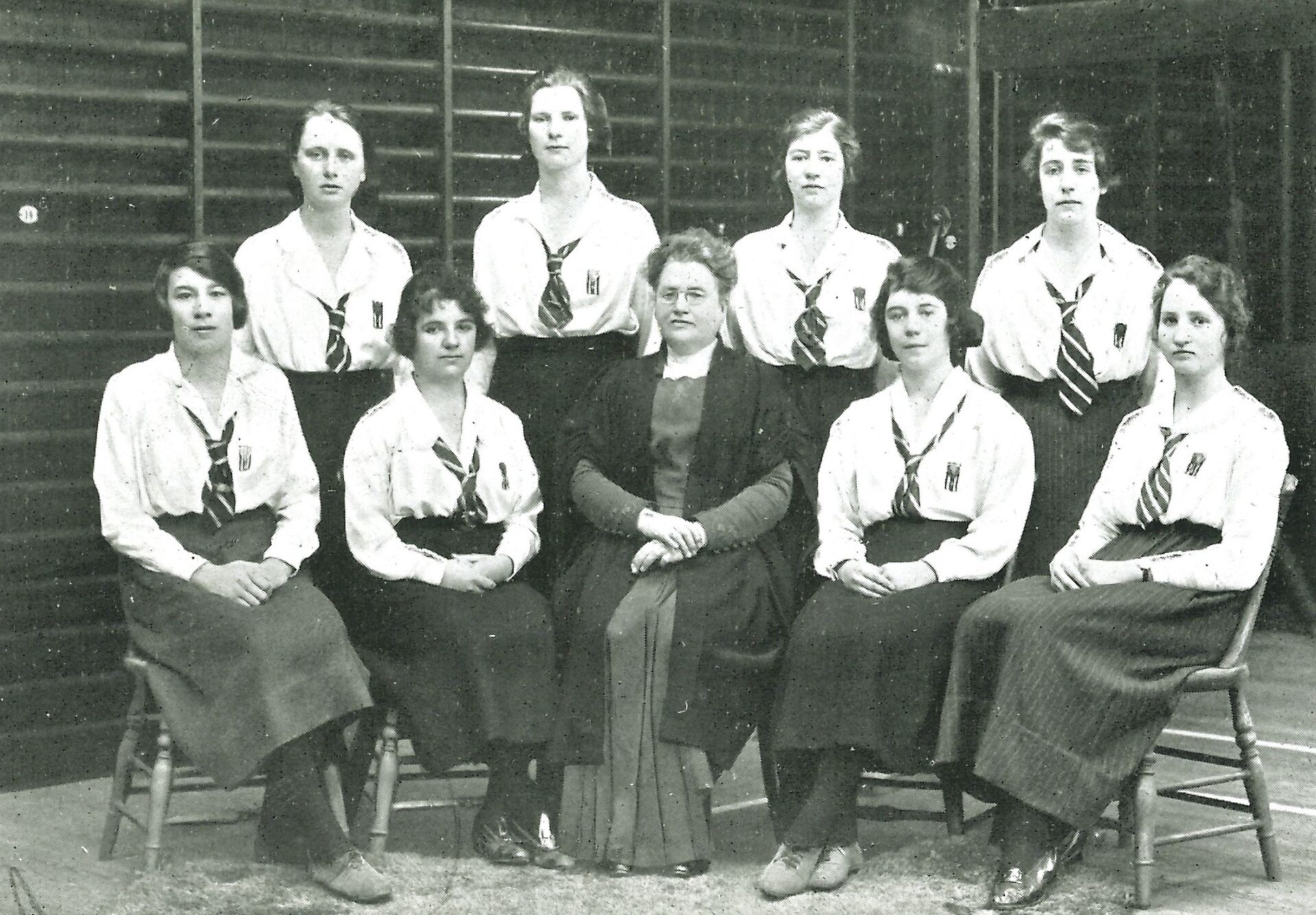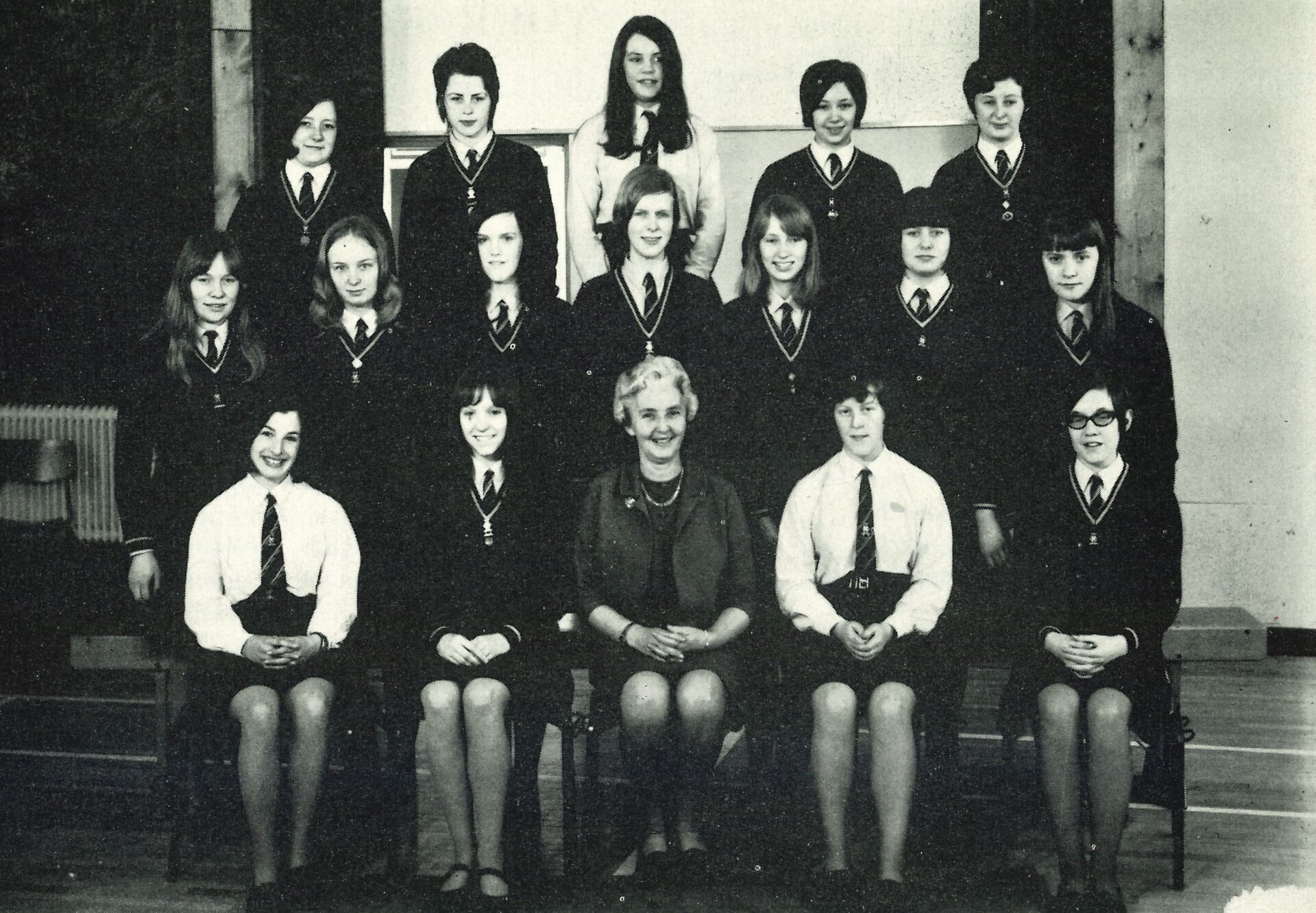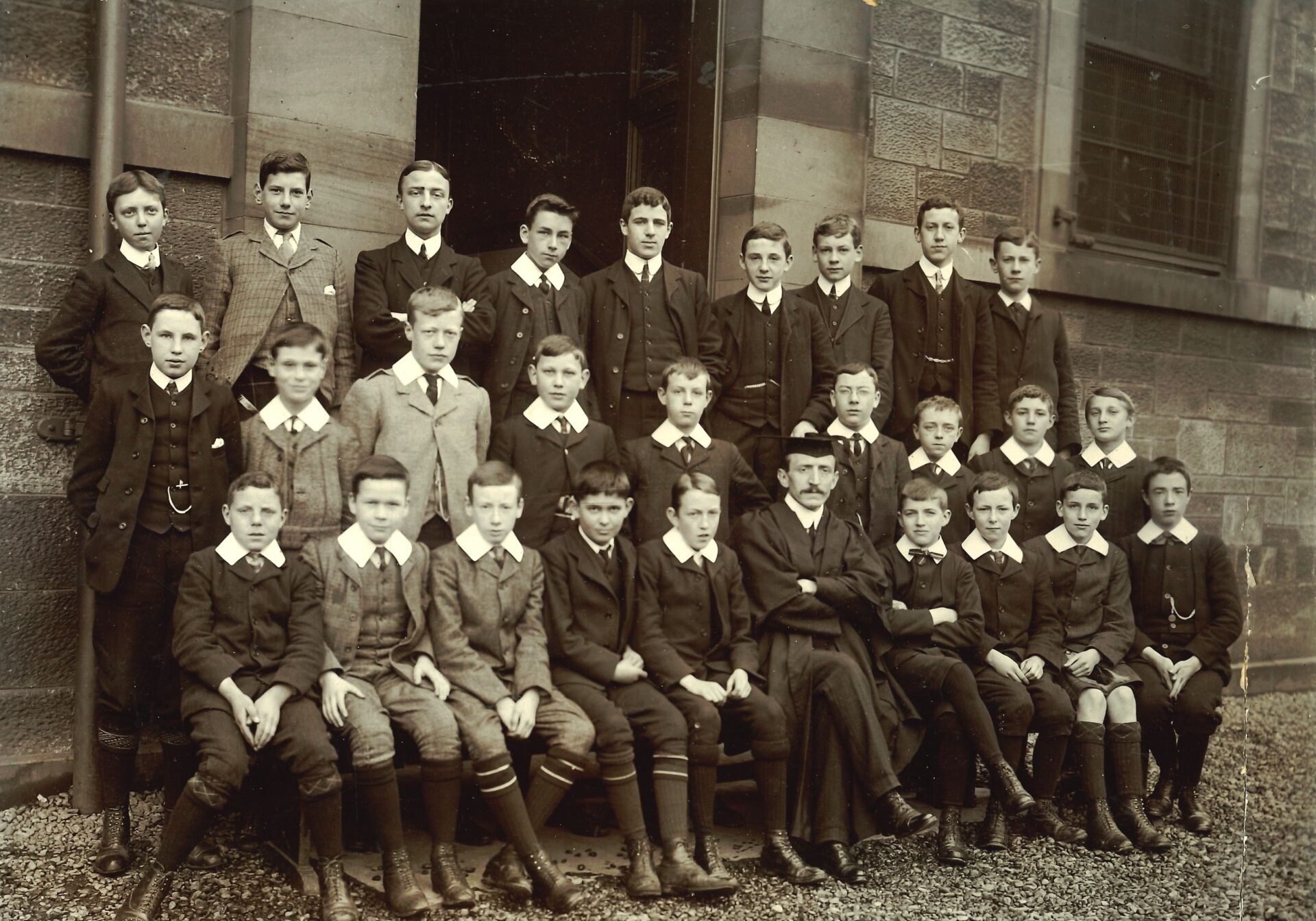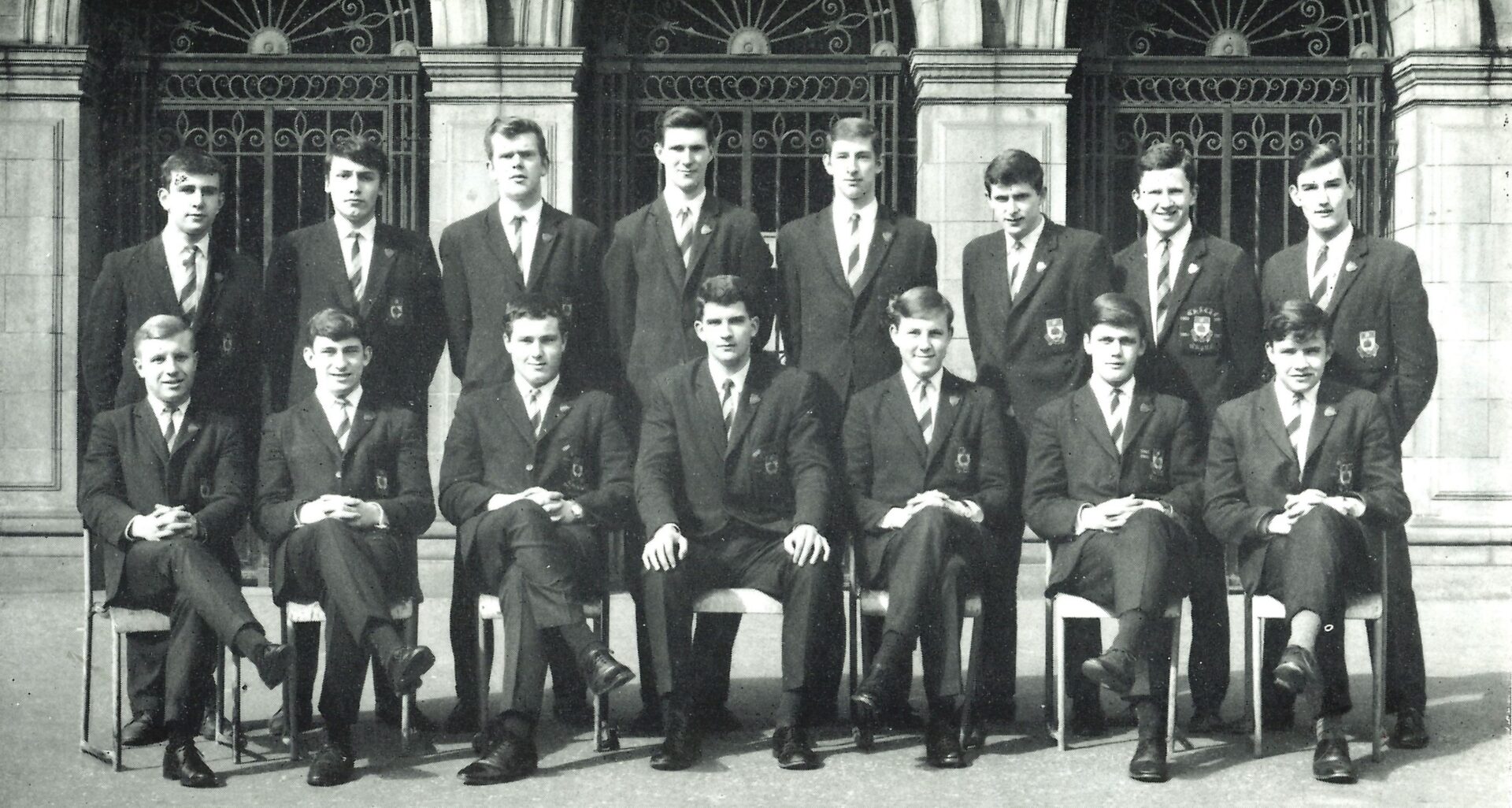HSOG History, Chapter 8: Developing our School’s identity
Every school develops its own unique identity, be that through its uniform and school colours, or by its traditions including School Songs and House systems. The High School of Glasgow is no different. This month’s instalment of HSOG History delves into the traditions that have been at the heart of the School over the years, and which are, or have historically been, synonymous with the High School’s identity.
This article will focus in particular on the 20th century and the uniforms, House systems and School Songs as well as the school colours, Crests and mottos which pupils will have been familiar with during the Elmbank Street and The Glasgow High School for Girls’ era.
Pictured above are the various school logos from throughout the history of The High School of Glasgow, spanning the era of the former boys’ and girls’ schools. The images on the top row show the development of the school logo for The Glasgow High School for Girls. Pictured L-R: the earliest school logo featuring a monogrammed design in the centre which spells “GSB” (the Glasgow School Board), a revised school logo which features the School Motto (Non Scholae Sed Vitae) as well as the School Crest, and lastly the most recent logo which bears many similarities to its predecessor, albeit in a more modern design. The images shown on the bottom row depict the development of the school logo for The High School of Glasgow’s former boys’ school. Pictured L-R: the earliest school logo dating from 1900-1911 featuring the School Motto at the time (Virtus Sola Nobilitas), the second logo dates from 1911-1919 and shows the revised School Motto (Haec Summa Est), and the most recent school logo featuring the School Motto Sursum Semper, both of which have remained unchanged into the present day.
The Glasgow High School for Girls – Forging GHSG’s Identity
Formerly known as Garnethill Public School, the name of our former girls’ school was changed to The Glasgow High School for Girls in 1894. During its 79-year history, the School was housed at two sites – first at Buccleuch Street until 1968, and latterly at 42 Cleveden Road from 1968-73.
During this period, the School’s identity developed, and so too did its traditions. Uniform regulations date back as early as the start of the 20th century, with the Prospectus from session 1914-15 noting that all pupils should be provided with an alternative pair of shoes to change into. Likewise, the girls were recommended to wear a hat featuring the school ribbon and were discouraged from wearing jewellery of any kind.
The wearing of a school hat continued into the mid-20th century, with a blue blazer also being a mandatory uniform requirement.

Under the leadership of Mrs Flora Tebb (Principal 1926-47), the School Song came into being having been composed by Miss Annie Scott Gow, a member of the Mathematics department from 1913-1939.
Entitled ‘Non Scholae Sed Vitae’, which was also the School Motto and translates as ‘we learn not for school but for life’, it comprised three verses with lyrics as follows:
Thy praise, our school, we sing today,
Well sung thy praise should be.
This tribute do we gladly pay
For all we owe to thee,
For minds alert and limbs well knit,
For hearts with glowing friendship lit,
Non scholae sed vitae.
Not all with high distinctions bring
New lustre to thy name,
But, all are privileged to sing
“We learn to play the game,
Each in her time to do her best,
To work and play alike with zest,”
Non scholae sed vitae.
The hill will miss the girls in blue
When from the hill we go,
But all that made the school we knew,
We still with pride shall show.
To those who come when we are gone,
With honour we shall hand it on,
Non scholae sed vitae.
A new School Crest, with four primary symbols, was also introduced during Tebb’s tenure. Designed by former pupil Miss Marguerite Benson, the Crest featured the golden lamp of learning, the oak tree of knowledge, the Cathedral for religion and Pegasus the winged horse to represent zeal and inspiration.
Combined, the four symbols were to represent ‘enlightenment through knowledge, culture and religion, to fit us for any enterprise.’ Also featured on the Crest was the School Motto, Non Schola Sed Vitae Discimus.
Following the end of the Second World War, the Girls’ School’s first House system was developed, comprising four Houses: Atholl, Douglas, Lochiel and Montrose.

Elmbank Street – Forging HSOG’s Identity
The High School of Glasgow was housed at Elmbank Street for just shy of one hundred years. Whilst its buildings still burn brightly in the memories of many of our former pupils today, so too do the School’s various traditions.
At the beginning of the 20th century, the school colours were maroon and yellow, having been introduced by Harry J Spenser (Rector from 1901-03). The School Motto at this time was Virtus Sola Nobilitas (roughly translated to ‘virtue is the only nobility’).
The turn of the century also saw the implementation of the School’s first uniform regulations, with all pupils required to wear one of three authorised caps or hats. The first being a maroon cap with an accompanying badge worked in yellow, the second a straw hat featuring the school colours on its band and the final option being a Glengarry cap (a traditional Scots cap made of thick-milled woollen material) with a silver school badge attached.
During this period, it’s likely that most boys will have donned the maroon cap, this option being the more affordable for most families. As per the Prospectus from session 1901-02, the cap or hats could be worn by any High School pupil, along with the school tie, belt and blazer.
To further promote the School’s sporting and extra-curricular activities, Spenser allowed the silver school badge to be worn on any cap belonging to members of the Cycling Club, whilst members of the First XV were permitted to wear the School Football cap with the school colours featuring on their jerseys, shirts and stockings. Only those in the First Cricket XI were afforded the opportunity to wear the school colours on a silk cap and sash.

Meanwhile, School Council members could wear the school cap with a gold badge, rather than a silver one.
With the founding of the School Cadet Corps in 1902 came further uniform regulations, with all boys expected to supply their own uniforms comprising a neutral green jacket, Douglas tartan kilt and hose, Glengarry cap, sporran, spats (a type of footwear accessory for outdoor wear, covering the instep and the ankle) and badges (the latter to be attached to the cap and sporran).
By session 1903-04, and under the leadership of the School’s third Rector, Frederic Spencer (1903-04), the school colours were changed to the Cameronian colours of green, blue and white. The cap remained unchanged and the badges silver, as it was deemed better suited to the “bumbee tartan”, as the new school colours were termed. The cap consisted of horizontal stripes of navy blue and green, each about three-quarters of an inch wide, accompanied by a narrow white strip. The new colours were certainly no favourite amongst the pupils, hence the nickname “bumbee”, which refers to a fabric woven like tartan, but which is designed with a lack of taste and history.
During Spencer’s one year in post, he also welcomed a new School Song, written by English and Classical Master, A L Taylor, and set to music by Dr A H Mann of King’s College in Cambridge. Although comprising four verses overall, typically only the first and final verses were sung by pupils. In the present day, this tradition still holds strong and the School Song remains unchanged since the early 1900s. We’re sure many former pupils will be able to recall the words of the School Song to this day:
O Alma Mater glorious
So great, so grave, so good,
We hail thy name victorious
With joy, with gratitude.
To those who trustful founded
Thy walls beloved be
Renown and love unbounded
Unbounded love to thee.
To those who follow after,
To fill the place we fill,
Who come with shout and laughter
For ours that shall be still,
We trust this sacred mission,
Pray God when we are gone,
They raise the high tradition,
And pass it glorious on.
Rector Shirley Goodwin introduced the House System in 1910 with the four Houses named after the following form teachers: Keen, Gillies, Taylor and Barclay. In April 1915, Gillies and Barclay Houses became Chalmers and Steel respectively.
Three years into Goodwin’s tenure, the School Colours were changed for a third and final time (until the present day!) to the renowned chocolate and gold. Around the same time, the School Motto became Haec Summa Est (translated roughly as ‘This is the sum’). Like its predecessor, this logo featured a variation of the Coat of Arms of Glasgow. However, the salmon with a ring in its mouth is substituted for three crossed fish, an emblem used in the early arms of the Bishops of Glasgow.

It was during Peter Pinkerton’s 16-year term as Rector that the House System underwent significant changes in 1917, with the Houses being renamed to commemorate former pupils: Bannerman, Campbell, Clyde and Moore. By session 1926-27, Campbell House became Law House. In contemporary High School life, these Houses have remained unchanged for more than a century. Pinkerton also welcomed a new School Motto, Sursum Semper (‘Ever Upwards’), one which has also held strong into the present day.
On 8th February 1919, the Lord Lyon King of Arms granted the School its coat of arms. The upper third of its shield being red and carrying an open book, with the edges of the pages gilded, between two laurel wreaths. The book and wreaths represent symbols of learning and reward. The lower part of the shield is identical to the Arms of the City of Glasgow, testament to the School’s long association with the city. It brings together symbols of the city’s origin attributed to the legends of the Patron Saint of Glasgow, St Mungo: the tree representing a bough kindled by a word into flame to relight the lights in his church extinguished by his enemies, the robin restored to life, the bell represents the Church and See of Glasgow and had been consecrated and brought by St Mungo from Rome. Lastly, the salmon with the ring in its mouth is a symbol of integrity and the Patron Saint’s role as a protector of the city’s honor.
This coat of arms remains synonymous with The High School of Glasgow today.
Much of the information included within this article was sourced from two books written by former members of staff: The Town School by Brian Lockhart and The High School of Glasgow by Harry Ashmall. Should you wish to read more about HSOG’s history, you can order copies of their books on our website here: www.hsogcommunity.co.uk/shop/.

